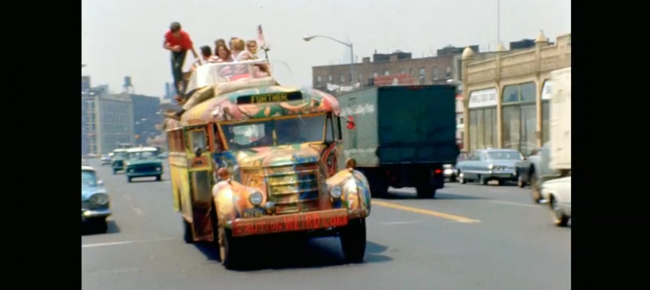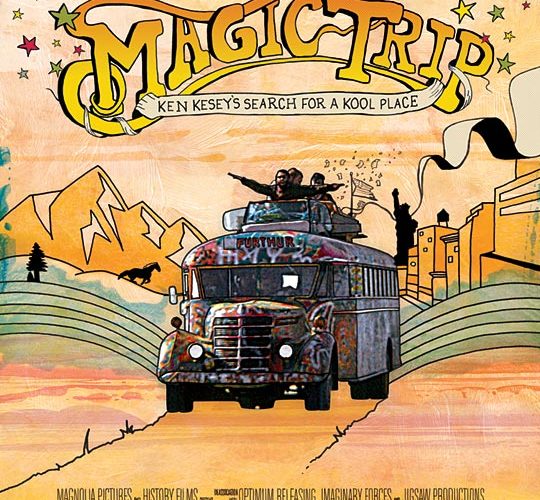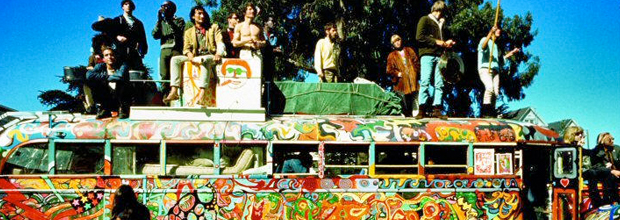There is no period in American history as overblown as the 1960s. Stories about the era are told in hushed, reverent tones, as if the participants were mythic figures, not people. Luckily, directors Alex Gibney (Taxi to the Dark Side, Gonzo: The Life and Work of Dr. Hunter S. Thompson) and Alison Ellwood bring a much-need dose of humanity into the epic tale of the counter-culture with Magic Trip: Ken Kesey’s Search for a Kool Place.
The film acts as a crash-course on the beginnings of what we know of as “the 60s,” anchored by the experiences of author Ken Kesey and his famed cross-country bus trip with The Merry Band Of Pranksters that helped kick off America’s love affair with acid. We view the changing of the American culture landscape as they’re doing it, viewing film that they created themselves on the trip as well as archival footage from the era itself. What’s so charming is that we get to view the events as they unfolded, not with the golden glow of hindsight and legend making. They were a part of an experience without any true idea of how important it would come to be.
Ken Kesey, the author of “One Flew Over The Cuckoo’s Nest,” is our protagonist (as much as there is one). Kesey was an all-American boy, a perfect bridge bridge between the wholesome, conservative 1950s and the radical, mind-bending 1960s. He was a varsity athlete at the University of Oregon, attended Stanford for graduate school, married his high school sweetheart and even trained for the Olympics in Greco-Roman wrestling. Then he was a participant in the government’s acid tests; a love affair was born and a nation was forever altered. After taking in the Broadway premiere of “Cookoo’s Nest,” Kesey and some friends walked by the construction of the World’s Fair in Queens. He made a promise to return to check out what the future would be like. Ironically, their presence was the future.
 The next year, Kesey and some like-minded friends nicknamed The Merry Band of Pranksters (each with their own individual monickers, like “Hardly Visible” and “Stark Naked”) bought an old bus, repainting it (numerous times) and christened it “Further.” Loaded with grass, alcohol, and LSD, “Further” took off for New York, piloted by the legendary Neal Cassady (the real-life “Dean Moriarty” in Jack Kerouac’s beatnik bible, “On The Road”). Upon their return to California, Kesey and the Pranksters held The Electric Kool-Aid Acid Test, immortalized in Tom Wolfe’s book of the same name, and helped spark a wave of acid use that quickly spread to the east coast, expanding minds and driving litigators crazy.
The next year, Kesey and some like-minded friends nicknamed The Merry Band of Pranksters (each with their own individual monickers, like “Hardly Visible” and “Stark Naked”) bought an old bus, repainting it (numerous times) and christened it “Further.” Loaded with grass, alcohol, and LSD, “Further” took off for New York, piloted by the legendary Neal Cassady (the real-life “Dean Moriarty” in Jack Kerouac’s beatnik bible, “On The Road”). Upon their return to California, Kesey and the Pranksters held The Electric Kool-Aid Acid Test, immortalized in Tom Wolfe’s book of the same name, and helped spark a wave of acid use that quickly spread to the east coast, expanding minds and driving litigators crazy.
This entire crazy, mixed-up experience is told directly from the point of view of Kesey and the Pranksters thanks to a wealth of film shot on the bus trip (over 100 hours of essentially non-synced film and audio), allowing us to sit in the bus with them. We see them trip and create tye-dye, have a little parade with instruments they can’t play, hang out with Allen Ginsberg, and ironically campaign for staunchly conservative presidential candidate Barry Goldwater. The real highlight of the film is the actual audio recording of Ken Kesey’s government-sponsored acid test. It’s a surreal bit of history brought to life in an equally-trippy animation sequence.
This film has been in pre-production for the last forty years, and it shows. It’s supposedly about Kesey, but the sections on him merely bookend the bus trip and all that came out of it (including clips from the classic acid episode of the TV show Dragnet). All of the footage used is archival, from the aforementioned film made during the trip to bits of newsreel footage and TV news pieces. The story is told through a variety of different voice over bits. Kesey’s views are re-purposed from various interviews about the era (the film features an all-purpose “narrator” voice that keeps it more uniform). The Pranksters watch the footage and act like it’s a DVD commentary track. But one of the pranksters, Jane Burton, has a delivery and word choice that sounds like she’s reading from a script. Add in the audio recorded from the trip itself and you have a lot of people talking in a lot of different clarity with a variety of tenses.
If it feels like the movie could be a bit of a confusing mess, well…it is. But, like the trip itself, it’s a beautiful mess. Considering the amount of information involved–and the sheer amount of footage that it was culled from–there is no conceivable way this could be an easily-digestible, streamlined film. Essentially, Magic Trip is the first part of a cultural documentary that peaks with Woodstock and ends with Gimme Shelter. Magic Trip is a bit long and shaggy, but so were the ’60s. There isn’t a more entertaining and engaging history lesson in theaters.


